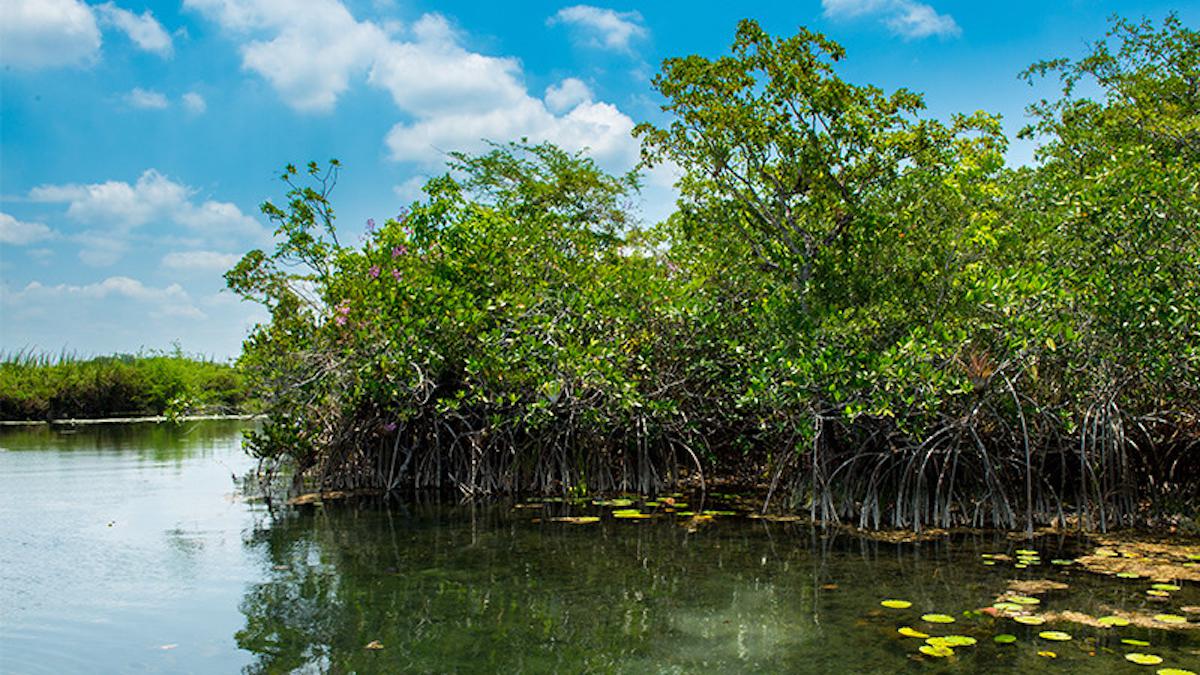
Mysterious Mangrove Forest Can Teach Us About Past and Future Sea Level Rise

A stand of red mangroves sits in the calm, calcium-rich, fresh waters of the San Pedro Mártir River. Ben Meissner
There’s a mystery growing in the heart of Mexico’s Yucatan Peninsula: a grove of red mangroves (Rhizophora mangle), which typically live in coastal waters, thriving 124 miles inland along the banks of the San Pedro Martir River.
Now, scientists think they have cracked the case. The forest is the remnants of a time around 125,000 years ago when global sea levels were much higher.
“Our finding highlights the extensive landscape impacts of past climate change on the world’s coastline and opens opportunities to better understand future scenarios of relative sea level rise,” the study authors wrote in the Proceedings of the National Academy of Sciences of the United States of America.
The research team decided to investigate this unique ecosystem because of the efforts of Carlos Burelo, a botanist at the Universidad Juárez Autónoma de Tabasco who grew up in the area, a University of California – San Diego press release explained.
“I used to fish here and play on these mangroves as a kid, but we never knew precisely how they got there,” Burelo said in the press release. “That was the driving question that brought the team together.”
To answer this question, the researchers looked at the genetic history of the trees to determine when they separated from coastal mangroves.
“[Mangroves’] genomes accumulate mutations every generation at a rate of about one in every 300 million letters of the genetic code, which will be passed on to future generations,” Queen Mary University of London evolutionary geneticist Richard Nichols, who was not part of the team, explained to Live Science. “By counting up the number of differences between two genomes it is possible to estimate the number of generations since those two genomes shared an ancestor.”
Using this method, the researchers were able to determine that the inland grove separated from coastal mangroves around 125,000 years ago. This was during the last interglacial period when temperatures were warmer, the polar ice caps had melted entirely and sea levels were 20 to 30 feet higher, the press release explained.
That makes the mangrove forest a “relict,” an ecosystem that has remained intact from an earlier era. In addition to the mangroves themselves, the researchers found almost 100 other species that had ocean origins, among them turtles, fish and plants, according to Live Science.
“This discovery is extraordinary,” study co-author Felipe Zapata of UCLA said in the press release. “Not only are the red mangroves here with their origins printed in their DNA, but the whole coastal lagoon ecosystem of the last interglacial has found refuge here.”
The finding can help scientists understand how the climate crisis might influence the region in the future. For example, the Tabasco lowlands surrounding the forest are so low that small changes in sea level rise had a big impact.
“There is certainly more to discover about how the many species in this ecosystem adapted throughout different environmental conditions over the past 100,000 years,” study co-author and Scripps Institution of Oceanography at UC San Diego marine ecologist Octavio Aburto-Oropeza said in the press release. “Studying these past adaptations will be very important for us to better understand future conditions in a changing climate.”
However, understanding the future also means preserving the past and present. The trees in the area surrounding the grove were felled in the 1970s for development, and the banks of the San Pedro Martir River were only preserved because they were too difficult to reach.
“We hope our results convince the government of Tabasco and Mexico’s environmental administration of the need to protect this ecosystem,” the study authors said in the release. “The story of Pleistocene glacial cycles is written in the DNA of its plants waiting for scientists to decipher it but, more importantly, the San Pedro mangroves are warning us about the dramatic impact that climate change could have on the coastal plains of the Gulf of Mexico if we do not take urgent action to stop the emission of greenhouse gases.”
If you want to learn more about this unique ecosystem, you can watch the award-winning short film “Memories of the Future: the modern discovery of a relict ecosystem,” by Scripps alumnus Ben Fiscella Meissner.
Deep in the heart of the Yucatan Peninsula, an ancient mangrove forest flourishes in fresh water more than 124 miles from the ocean. How is this possible? Scripps' @octavioaburto and a team of researchers examine this unique ecosystem in a new study: https://t.co/YRLWccr3bs pic.twitter.com/vMzQp5Y6tG
— Scripps Institution of Oceanography (@Scripps_Ocean) October 4, 2021
- How Protecting Wetlands Can Help the Climate - EcoWatch
- Protecting Mangroves Can Prevent Billions of Dollars in Global ...
- Mangroves Could Help Save Us From Climate Change. Climate ...
- Sea level rise is killing trees along the Atlantic coast, creating 'ghost ...

 233k
233k  41k
41k  Subscribe
Subscribe 